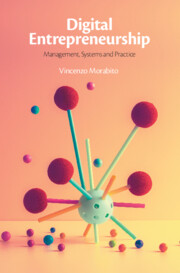Book contents
- Digital Entrepreneurship
- Digital Entrepreneurship
- Copyright page
- Contents
- Figures
- Tables
- Acknowledgments
- Abbreviations
- Introduction
- Part I Strategy and Management
- Part II Digital Business Systems
- 5 Digital ICT Challenges for Digital Entrepreneurship
- 6 Digital Entrepreneurship and Social Media
- 7 Digital Entrepreneurship and the Internet of Things (IoT)
- 8 Digital Entrepreneurship and Blockchain
- Part III Industries
- Index
- References
7 - Digital Entrepreneurship and the Internet of Things (IoT)
from Part II - Digital Business Systems
Published online by Cambridge University Press: 16 December 2021
- Digital Entrepreneurship
- Digital Entrepreneurship
- Copyright page
- Contents
- Figures
- Tables
- Acknowledgments
- Abbreviations
- Introduction
- Part I Strategy and Management
- Part II Digital Business Systems
- 5 Digital ICT Challenges for Digital Entrepreneurship
- 6 Digital Entrepreneurship and Social Media
- 7 Digital Entrepreneurship and the Internet of Things (IoT)
- 8 Digital Entrepreneurship and Blockchain
- Part III Industries
- Index
- References
Summary
The Internet of Things (IoT) plays a vital role in the implementation and success of digital entrepreneurship. The IoT refers to the interconnection of smart devices, physical devices, buildings as well as other objects and devices that have inherent software, electronics, actuators, network connectivity and sensors that make it possible for these objects and devices to exchange and collect data. The use of the IoT for entrepreneurship can bring about a level playing field in various sectors of the economy in which opportunities such as working remotely at any time and on-the-go are created. This chapter gives a clear understanding of the IoT, its advantages for digital entrepreneurship as well as its potential future.
- Type
- Chapter
- Information
- Digital EntrepreneurshipManagement, Systems and Practice, pp. 135 - 149Publisher: Cambridge University PressPrint publication year: 2022



